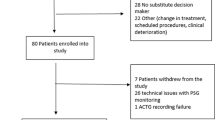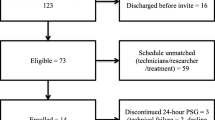Abstract
Objective
Sleep loss and sleep disruption are common in critically ill patients and may adversely affect clinical outcomes. Although polysomnography remains the most accurate and reliable way to measure sleep, it is costly and impractical for regular use in the intensive care unit. This study evaluates the accuracy of two other methods currently used for measuring sleep, actigraphy (monitoring of gross motor activity) and behavioural assessment by the bedside nurse, by comparing them to overnight polysomnography in critically ill patients.
Design
Observational study with simultaneous polysomnography, actigraphy and behavioural assessment of sleep.
Setting
Medical-surgical intensive care unit.
Patients and participants
Twelve stable, critically ill, mechanically ventilated patients [68 (13) years, Glasgow coma scale 11 (0)].
Interventions
None.
Measurements and results
Sleep was severely disrupted, reflected by decreased total sleep time and sleep efficiency, high frequency of arousals and awakenings and abnormal sleep architecture. Actigraphy overestimated total sleep time and sleep efficiency. The overall agreement between actigraphy and polysomnography was <65%. Nurse assessment underestimated the number of awakenings from sleep. Estimated total sleep time, sleep efficiency and number of awakenings by nurse assessment did not correlate with polysomnographic findings.
Conclusions
Actigraphy and behavioural assessment by the bedside nurse are inaccurate and unreliable methods to monitor sleep in critically ill patients.



Similar content being viewed by others
References
Hanly P (2006) Sleep in the ventilated patient. In: Tobin M (ed) Principles and practice of mechanical ventilation, 2nd edn. McGraw-Hill, New York, pp 1173–1184
Cooper AB, Gabor JY, Hanly PJ (2001) Sleep in the critically ill patient. Semin Respir Crit Care Med 22:153–164
Gabor JY, Cooper AB, Hanly PJ (2001) Sleep disruption in the intensive care unit. Curr Opin Crit Care 7:21–27
Weinhouse GL, Schwab RJ (2006) Sleep in the critically ill patient. Sleep 29:707–716
Aurell J, Elmqvist D (1985) Sleep in the surgical intensive care unit: continuous polygraphic recording of sleep in nine patients receiving postoperative care. Br Med J (Clin Res Ed) 290:1029–1032
Broughton R, Baron R (1978) Sleep patterns in the intensive care unit and on the ward after acute myocardial infarction. Electroencephalogr Clin Neurophysiol 45:348–360
Cooper AB, Thornley KS, Young GB, Slutsky AS, Stewart TE, Hanly PJ (2000) Sleep in critically ill patients requiring mechanical ventilation. Chest 117:809–818
Freedman NS, Gazendam J, Levan L, Pack AI, Schwab RJ (2001) Abnormal sleep/wake cycles and the effect of environmental noise on sleep disruption in the intensive care unit. Am J Respir Crit Care Med 163:451–457
Gabor JY, Cooper AB, Crombach SA, Lee B, Kadikar N, Bettger HE, Hanly PJ (2003) Contribution of the intensive care unit environment to sleep disruption in mechanically ventilated patients and healthy subjects. Am J Respir Crit Care Med 167:708–715
Hilton BA (1976) Quantity and quality of patients’ sleep and sleep-disturbing factors in a respiratory intensive care unit. J Adv Nurs 1:453–468
Kavey NB, Ahshuler KZ (1979) Sleep in herniorrhaphy patients. Am J Surg 138:683–687
Orr WC, Stahl ML (1977) Sleep disturbances after open heart surgery. Am J Cardiol 39:196–201
Richards KC, Bairnsfather L (1988) A description of night sleep patterns in the critical care unit. Heart Lung 17:35–42
Knill RL, Moote CA, Skinner MI, Rose EA (1990) Anesthesia with abdominal surgery leads to intense REM sleep during the first postoperative week. Anesthesiology 73:52–61
Rosenberg J, Wildschiodtz G, Pedersen MH, von Jessen F, Kehlet H (1994) Late postoperative nocturnal episodic hypoxaemia and associated sleep pattern. Br J Anaesth 72:145–150
Bosma K, Ferreyra G, Ambrogio C, Pasero D, Mirabella L, Braghiroli A, Appendini L, Mascia L, Ranieri VM (2007) Patient–ventilator interaction and sleep in mechanically ventilated patients: pressure support versus proportional assist ventilation. Crit Care Med 35:1048–1054
Parthasarathy S, Tobin MJ (2002) Effect of ventilator mode on sleep quality in critically ill patients. Am J Respir Crit Care Med 166:1423–1429
Hardin KA, Seyal M, Stewart T, Bonekat HW (2006) Sleep in critically ill chemically paralyzed patients requiring mechanical ventilation. Chest 129:1468–1477
Fontaine DK (1989) Measurement of nocturnal sleep patterns in trauma patients. Heart Lung 18:402–410
Horne JA (1998) Why we sleep: the functions of sleep in humans and other mammals. Oxford University Press, Oxford
Hansell HN (1984) The behavioral effects of noise on man: the patient with “intensive care unit psychosis”. Heart Lung 13:59–65
Ely EW, Gautam S, Margolin R, Francis J, May L, Speroff T, Truman B, Dittus R, Bernard R, Inouye SK (2001) The impact of delirium in the intensive care unit on hospital length of stay. Intensive Care Med 27:1892–1900
Kollef MH, Levy NT, Ahrens TS, Schaiff R, Prentice D, Sherman G (1998) The use of continuous i.v. sedation is associated with prolongation of mechanical ventilation. Chest 114:541–548
Chen HI, Tang YR (1989) Sleep loss impairs inspiratory muscle endurance. Am Rev Respir Dis 140:907–909
Cooper KR, Phillips BA (1982) Effect of short-term sleep loss on breathing. J Appl Physiol 53:855–858
White DP, Douglas NJ, Pickett CK, Zwillich CW, Weil JV (1983) Sleep deprivation and the control of ventilation. Am Rev Respir Dis 128:984–986
Schiffman PL, Trontell MC, Mazar MF, Edelman NH (1983) Sleep deprivation decreases ventilatory response to CO2 but not load compensation. Chest 84:695–698
Benca RM, Quintas J (1997) Sleep and host defenses: a review. Sleep 20:1027–1037
Parthasarathy S, Tobin MJ (2004) Sleep in the intensive care unit. Intensive Care Med 30:197–206
Toublanc B, Rose D, Glérant JC, Francois G, Mayeux I, Rodenstein D, Jounieaux V (2007) Assist-control ventilation vs. low levels of pressure support ventilation on sleep quality in intubated ICU patients. Intensive Care Med 33:1148–1154
Alexopoulou C, Kondili E, Vakouti E, Klimathianaki M, Prinianakis G, Georgopoulos D (2007) Sleep during proportional-assist ventilation with load-adjustable gain factors in critically ill patients. Intensive Care Med 33:1139–1147
Rechtschaffen A, Kales A (1968) A manual of standardized terminology, techniques and scoring system for sleep stages of human subjects (NIH publication no. 204). Brain Information Service/Brain Research Institute, UCLA, Los Angeles
Sadeh A, Hauri PJ, Kripke DF, Lavie P (1995) The role of actigraphy in the evaluation of sleep disorders. Sleep 18:288–302
Shilo L, Dagan Y, Smorjik Y, Weinberg U, Dolev S, Komptel B, Balaum H, Shenkman L (1999) Patients in the intensive care unit suffer from severe lack of sleep associated with loss of normal melatonin secretion pattern. Am J Med Sci 317:278–281
Shilo L, Dagan Y, Smorjik Y, Weinberg U, Dolev S, Komptel B, Shenkman L (2000) Effect of melatonin on sleep quality of COPD intensive care patients: a pilot study. Chronobiol Int 17:71–76
Morgenthaler T, Alessi C, Friedman L, Owens J, Kapur V, Boehlecke B, Brown T, Chesson A Jr, Coleman J, Lee-Chiong T, Pancer J, Swick TJ (2007) Practice parameters for the use of actigraphy in the assessment of sleep and sleep disorders: an update for 2007. Sleep 30:519–529
Bourne RS, Minelli C, Mills GH, Kandler R (2007) Clinical review: sleep measurement in critical care patients: research and clinical implications. Crit Care 11:226
Watson PL (2007) Measuring sleep in critically ill patients: beware the pitfalls. Crit Care 11:159
Edwards GB, Schuring LM (1993) Pilot study: validating staff nurses’ observations of sleep and wake states among critically ill patients, using polysomnography. Am J Crit Care 2:125–131
Olson DM, Borel CO, Laskowitz DT, Moore DT, McConnell ES (2001) Quiet time: a nursing intervention to promote sleep in neurocritical care units. Am J Crit Care 10:74–78
Richardson A, Crow W, Coghill E, Turnock C (2007) A comparison of sleep assessment tools by nurses and patients in critical care. J Clin Nurs 16:1660–1668
Beecroft J, Ward M, Younes M, Crombach S, Smith O, Lukic D, Lawrence J, Hanly P (2005) Sleep monitoring in the intensive care unit: comparison of nurse assessment, actigraphy and polysomnography. Proc Am Thorac Soc 2:A793
Riker RR, Picard JT, Fraser GL (1999) Prospective evaluation of the sedation–agitation scale for adult critically ill patients. Crit Care Med 27:1325–1329
Jacobson S, Jerrier H (2000) EEG in delirium. Semin Clin Neuropyschiatry 5:86–92
Miller RRIII, Ely EW (2006) Delirium and cognitive dysfunction in the intensive care unit. Semin Respir Crit Care Med 27:210–220
Acknowledgments
This research was performed at the Medical Surgical Intensive Care Unit, St. Michael’s Hospital, Toronto, ON, Canada and was supported by The Physicians Services Incorporated Foundation, ON, Canada. The authors would like to thank D. Lukic and J. Lawrence for their technical assistance.
Author information
Authors and Affiliations
Corresponding author
Appendix: Nursing questionnaire
Appendix: Nursing questionnaire
Nursing assessment of sleep
-
1.
How many hours did your patient sleep during the study period? ……hours.
-
2.
How many times did your patient wake during the study period? ……times.
Rights and permissions
About this article
Cite this article
Beecroft, J.M., Ward, M., Younes, M. et al. Sleep monitoring in the intensive care unit: comparison of nurse assessment, actigraphy and polysomnography. Intensive Care Med 34, 2076–2083 (2008). https://doi.org/10.1007/s00134-008-1180-y
Received:
Accepted:
Published:
Issue Date:
DOI: https://doi.org/10.1007/s00134-008-1180-y




